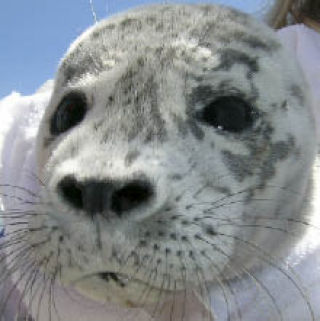Once again, harbor seal pupping season in San Juan County is fast approaching.
The San Juan County Marine Mammal Stranding Network (the Stranding Network) depends on private citizens to help by reporting stranded animals — both dead and alive — in San Juan County.
Thanks to aerial survey counts conducted by the Department of Fish and Wildlife, we know that the harbor seal population in the San Juan Islands is believed to be at carrying capacity for the system. This means that populations are stable and not growing due to limitations of the ecosystem like food availability.
In San Juan County alone, we have about 4,000 seals. Assuming half the population is female and only half of those females are reproductively active, we can expect 1,000+ seal pups to be born in San Juan County this year!
It is not surprising that every summer the Stranding Network receives hundreds of calls from shoreline residents and visitors who find stranded seal pups. It can be very difficult to leave a beached pup alone, but that could be the pup’s only chance for survival. Sometimes, mothers will place their pups on a beach while they go out and forage and will only come back for their pup if the area remains clear of people and pets.
Another thing to keep in mind is that out of the 1,000+ seals born, many will not survive for various reasons. According to Amy Traxler, coordinator of the Stranding Network, “I know it’s extremely difficult and heartbreaking to leave a pup on the beach and let nature take its course but, like it or not, this is the way nature controls the population numbers. As with most wildlife, not all of the pups born are going to survive.”
That doesn’t mean that the Stranding Network doesn’t pick up any of these pups. Pups are rescued, however, only when they meet the strict regulations authorized by the National Oceanic and Atmospheric Administration (NOAA), the federal agency that permits the Stranding Network to operate.
In 1998, approximately half of the 36 live harbor seal pups found and reported in San Juan County were picked up and brought to Wolf Hollow Wildlife Rehabilitation Center. However, with increased awareness and more harbor seals in the area, the number of calls coming in every year increases, which has resulted in a dramatic shift over the last 10 years. Last year, with 118 live pup calls coming in just between June and August, the percentage of pups picked up is much lower than it was 10 years ago. This frustrates some long-time residents who, in the past, frequently had “their” pups picked up.
“Shoreline residents and private citizens have to realize that if they have a pup on their beach in July, there are likely ten other residents in San Juan County dealing with the same thing on the same day,” Traxler said. “This is one of the hardships of living on the water.”
It’s also very important to remember that all marine mammals are protected under the Marine Mammal Protection Act and people who have picked up seal pups in the past without authorization have been fined by NOAA.
If you find a stranded marine mammal, please call the Stranding Network’s hotline number at (800) 562-8832 and leave a message that includes the species of animal and exact stranding location. Next, try to keep dogs and people away. If possible, try to tell if the animal is dead or alive, estimate how long it is and note any distinguishing marks, obvious wounds or injuries.
The most important thing to remember is that all stranded marine mammals, whether live or dead, provide a unique opportunity to learn about their populations. Tracking stranded animals allows us to monitor diseases, contaminant levels, and the impact of humans on these populations.
If you’d like to be a Network volunteer, call Amy at 378-4710, ext. 27, or e-mail her at amy@whalemuseum.org.
— This column was submitted by the San Juan County Marine Mammal Stranding Network.



